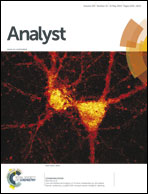Electrochemical sensing of hepatocyte viability†
Abstract
We investigated the use of amperometric and chronoamperometric methods with a double mediator system and screen-printed electrodes (SPEs) for the electrochemical sensing of hepatocyte viability. Cell counts were determined based on measuring cellular respiration via interaction of electroactive redox mediators. The oxidation currents of chronoamperometric measurement were proportional to the concentrations of ferrocyanide which was produced via interaction of cellular respiration, succinate and ferricyanide. The integrated oxidation charges increased linearly with the density of the cultured primary rat hepatocytes over a range of 1 × 105 to 5 × 105 cells per well (slope = 1.98 (±0.08) μC per 105 cells; R2 = 0.9969), and the detection limit was 7600 (±300) cells per well based on S/N = 3. Each density of cells was cultured in triple replicates and individual cell samples were evaluated. The results of the cytotoxic effect of the chronoamperometric method are comparable to those of the tetrazolium-based colorimetric assay. The chronoamperometric method with ferricyanide and succinate mediators is an efficient, alternative method for assessing the viability of primary hepatocytes which can be completed in 20 min. Succinate did not provide an efficient electron shuttle between cytosolic respiratory redox activity of cancer cells and extracellular ferricyanide, an effect that may be useful for distinguishing hepatocarcinoma cells from healthy hepatocytes.


 Please wait while we load your content...
Please wait while we load your content...